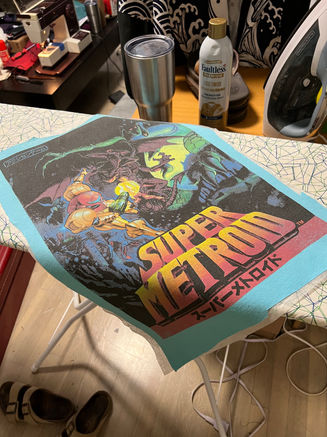top of page

Overdyed denim Jacket and Custom T-shirt patch
2022
Whether a shirt has been stained, torn, or simply doesn't fit, converting it into a patch is a great way to preserve its design and apply it to another garment. Applying fusible interfacing helps stabilize the shape of the stretchy jersey fabric for a clean finish.
I researched the history of Levi's jackets and was surprised to learn that the jacket we are most used to seeing is actually the third version, commonly referred to as the "type 3" by denim enthusiasts. I really liked the front pleats and different body shape of the type 2, so I immediately set out to buy one. Unfortunately, my bubble was quickly burst, as it was only available from high-end vintage replica companies with a hefty price tag.
A couple years later, my luck turned, as the design became more trendy and became more available at a lower price point. I ended up buying two stone washed examples on clearance from urban outfitters. I certainly didn't need two identical jackets, but I had a plan for that. I dyed the jacket first with standard Rit dye, which did a good job on the cotton fabric, but left me with goldenrod stitching, which was a stark contrast against the newly black denim. I gave it a second round using iDye Poly, which took nicely to the stitching.
With that taken care of, there was one other standout element: the bright silver buttons. I wanted something that wouldn't flake off as I wore and washed the jacket. Getting strong adhesion to smooth metal is not very easy with standard spray paint, so I looked into my other options. Looking in the spray paint aisle, I saw something intriguing: black appliance epoxy paint. Epoxy tends to be a very durable finish, and appliances are usually smooth metal boxes, so I gave it a try. I masked the jacket off behind the buttons and sprayed on two coats. This really completed the full black-on-black look that I wanted, and has held up well since. It is now my go-to solution for hiding shiny metal parts.
An old friend of mine gave me this t-shirt featuring the box art of Super Metroid, one of my favorite games of all time. Unfortunately, the shirt had a very boxy fit that really didn't work for me, so I decided to use it to decorate one of my favorite jackets instead.
I have done this many times before, so I didn't hesitate to pull out my scissors and cut out the graphic, leaving a wide margin. Cotton jersey, the fabric most tees are made from, has a tendency to curl up at the edges, so I ironed and starched the piece. After that, I ironed on some thin fusible interfacing. This removes the stretch and curl of the jersey, making it much easier to cut and sew it. In this case, since I planned to put the patch onto a rigid denim jacket, removing the stretch would also help the patch mimic the behavior of the jacket. If I were applying to another shirt or other stretchy garment, I would use a dissolvable interfacing, so the patch could return to its original behavior after washing.
I trimmed the patch, leaving a quarter inch of the blue fabric exposed, as I felt it would make for a nice contrast against the black jacket. It also made it possible to match the thread color to the edge using only one color.
After the final trim, the patch was ready to go on. I ironed the jacket for good measure and centered the patch before pinning it. Using such a thin material as a patch, I chose a zigzag stitch to make sure the edge wouldn't lift. Making sure such a large and flexible patch stays flat can be challenging, so I took care to check its alignment every couple of inches.
I think that the jacket is now one of a kind, and greater than the sum of its parts. I love the results, and I am glad that I could repurpose such a thoughtful gift and keep using it, even if it wasn't originally a great fit for my body.


bottom of page













